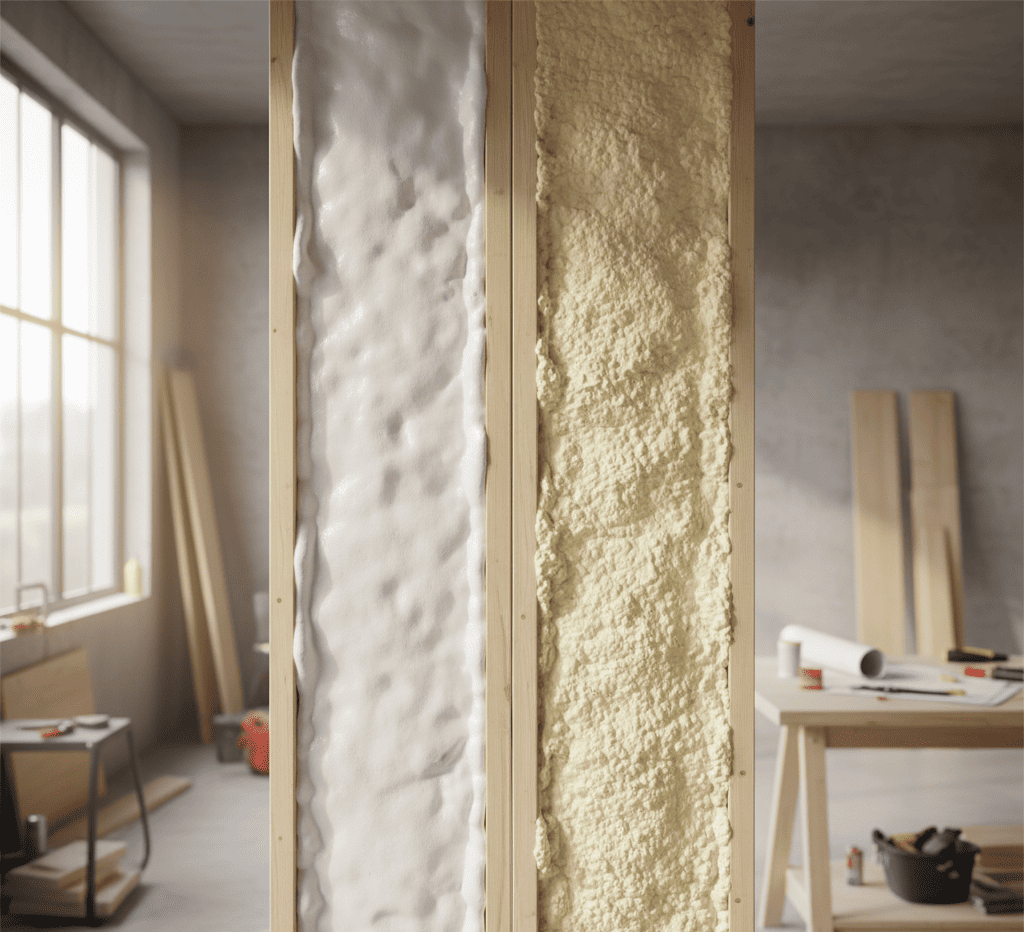Spray foam insulation has grown in popularity over the last decade among homeowners, DIYers, and contractors. Known for its ability to deliver excellent thermal resistance, reduce air leakage, and improve overall comfort, it has become one of the most reliable insulation options available today.
When people first consider spray foam, a common question comes up: what’s the difference between closed-cell spray foam insulation and open-cell spray foam insulation?
Both belong to the same family of materials but serve very different purposes. Picking the wrong one can lead to higher energy bills, wasted money, or even moisture issues over time. Understanding how the two types compare especially in cost, performance, and durability can help ensure you choose the right insulation for your project.
Key Takeaways
-
Closed-cell spray foam insulation has R-6 to R-7 per inch, higher thermal resistance than open-cell’s R-3.5 to R-4.
-
Open-cell foam is cheaper and better for soundproofing, while closed-cell foam adds structural strength and resists moisture.
-
Spray foam insulation cost per sq ft ranges $0.45–$0.65 for open-cell and $1.00–$1.50 for closed-cell.
-
Closed-cell foam functions as both air and vapor barrier, preventing moisture buildup and mold growth in walls and basements.
Understanding Spray Foam Insulation Types
Spray foam insulation comes in two main forms: closed-cell and open-cell. While both expand upon application to fill cracks and gaps, their internal structure determines performance.
-
Closed-cell spray foam insulation has cells that are completely sealed. This makes it rigid, dense, and resistant to water.
-
Open-cell spray foam insulation has partially open bubbles inside. This makes it softer, lighter, and better at absorbing sound.
Even though both provide air sealing insulation foam, they are suited to different areas of a home or building. Knowing these distinctions helps avoid DIY mistakes with open-cell foam or underusing the benefits of closed-cell foam.
Comparison Table: Closed-Cell vs. Open-Cell Foam
|
Feature |
Closed-Cell Spray Foam |
Open-Cell Spray Foam |
|
R-Value per inch |
R-6 to R-7 |
R-3.5 to R-4 |
|
Density |
High (rigid, strong) |
Low (soft, flexible) |
|
Moisture Resistance |
Excellent – acts as vapor barrier |
Poor – can absorb water |
|
Soundproofing |
Moderate |
Strong – absorbs noise |
|
Structural Strength |
Adds strength to walls & roofs |
Provides no added structural support |
|
Cost |
Higher ($1.00–$1.50/board foot) |
Lower ($0.45–$0.65/board foot) |
|
Best Applications |
Basements, crawlspaces, exterior walls, garages, humid climates |
Attics, interior walls, ceilings, dry climates |
|
Longevity/ROI |
Longer-lasting, higher ROI |
Affordable upfront but less durable |
R-Value Explained: Thermal Resistance of Spray Foam
The R-value is one of the most important factors in insulation. It measures how well a material resists heat flow. The higher the R-value, the better the insulation performance.
-
Closed-cell spray foam insulation: Provides about R-6 to R-7 per inch, making it one of the highest-performing insulation materials available. Its higher density gives it superior thermal resistance, which translates to significant energy savings over time.
-
Open-cell spray foam insulation: Offers R-3.5 to R-4 per inch. While effective in many interior applications, it does not perform as well in extreme temperatures or where maximum efficiency is required.
Essential Point: If you are focused on maximizing efficiency and reducing heating and cooling bills, closed-cell foam will deliver the best results. Open-cell may be sufficient for interior walls or less demanding projects.
Cost of Closed vs Open Cell Foam
Cost is often the deciding factor for homeowners and contractors. The spray foam insulation cost per sq ft depends on type and project size.
-
Open-cell foam: Around $0.45 – $0.65 per board foot. This makes it one of the most affordable insulation alternatives and a good choice for large-scale interior projects on a budget.
-
Closed-cell foam: Around $1.00 – $1.50 per board foot. More expensive upfront, but delivers a stronger insulation ROI for homeowners because of reduced energy bills and longer-lasting durability.
Cost Example: If insulating a 1,000 sq ft attic, open-cell may save several hundred dollars upfront. However, closed-cell could cut monthly utility costs more significantly, paying for itself in the long run.
Pro Tip: Consider a closed-cell vs open-cell cost comparison not just in terms of purchase price, but also lifetime savings.
Moisture Barrier and Mold Prevention
Moisture control is where closed-cell foam clearly outperforms. Its dense, sealed-cell structure resists water absorption, functioning as both an air barrier and vapor barrier.
-
Closed-cell spray foam insulation: Acts as a true moisture barrier insulation, preventing condensation and protecting against mold growth. It’s ideal for basements, crawl spaces, and any area prone to dampness.
-
Open-cell spray foam insulation: More breathable, which can be useful in certain attic applications, but it absorbs water if exposed to leaks or flooding. This makes it less reliable in humid climates.
When retrofitting old homes or insulating basements, closed-cell is the safer long-term choice. It prevents costly repairs and offers peace of mind.
Soundproofing Benefits
When it comes to noise reduction, open-cell foam wins. Its lightweight, sponge-like texture absorbs sound waves effectively, making it popular for:
- Home theaters
- Bedrooms
- Interior walls
Closed-cell foam is denser, so it blocks some sound, but not as well. For homeowners prioritizing comfort and quiet, insulation designed with an open-cell structure is often the better fit, helping reduce noise while maintaining a cozy indoor environment.
Spray Foam Safety and Installation
Safety during installation is crucial for both foam types. Spray foam releases chemicals during application, so proper ventilation is essential.
Installation Guide Essentials:
- Wear protective gear including gloves, goggles, and a respirator.
- Ensure proper airflow with fans or open windows.
-
Avoid reoccupying the space until recommended cure time passes.
DIY mistakes with open-cell foam often include overspraying, underfilling cavities, or applying foam in humid conditions. Following instructions carefully prevents these issues and ensures maximum performance.

Environmental Impact of Spray Foam
Both foam types reduce a building’s long-term environmental footprint by lowering energy consumption. However, manufacturing impacts and chemical blowing agents are common concerns.
Modern formulations, like PurpleCoat Closed-Cell Foam, use eco-friendlier chemistry that balances performance with sustainability. Over the lifetime of a home, energy savings from high-R-value insulation far outweigh the initial footprint of the material itself.
Structural Strength: The Closed-Cell Advantage
Unlike open-cell, closed-cell spray foam insulation adds structural strength to whatever it bonds with. Its rigid nature reinforces walls, roofs, and foundations.
- Helps stabilize older homes during retrofits.
- Strengthens roofs in areas prone to storms.
-
Provides added durability for garages and workshops.
For contractors and handymen, this makes closed-cell foam the go-to option where extra rigidity is desired. Our detailed overview of the Vega Bond V600 explores how it performs under demanding conditions.
Where Each Foam Works Best
Here’s a simple guide to choosing:
-
Closed-cell spray foam insulation: Best for basements, crawl spaces, exterior walls, garages, and humid climates. Its higher R-value and moisture resistance make it a long-term investment.
-
Open-cell spray foam insulation: Best for attics, ceilings, bedrooms, and interior walls. Its affordability and soundproofing qualities make it attractive for indoor projects.
VB Insulation Spotlight: PurpleCoat™ Closed-Cell Foam

VB Insulation’s PurpleCoat™ Closed-Cell Foam takes insulation performance a step further. Designed for homeowners, DIYers, and light commercial users, it provides:
- High R-value per inch for maximum thermal efficiency.
- Superior moisture protection as a vapor barrier.
- Excellent adhesion to wood, concrete, masonry, and metal.
- Enhanced rigidity and durability compared to typical closed-cell foams.
FAQs About Closed-Cell and Open-Cell Foam
Can PurpleCoat foam be used outdoors or exposed to UV light?
No. PurpleCoat foam must be protected if used outdoors. UV exposure degrades the foam, so cover it with paint, coating, or cladding.
How durable is PurpleCoat closed-cell foam vs typical closed-cell alternatives?
PurpleCoat is engineered for extra rigidity and compressive strength, making it longer-lasting than many standard closed-cell options.
What surfaces will PurpleCoat adhere to (wood, concrete, metal, etc.)?
It bonds effectively to wood, concrete, masonry, and metal, provided the surface is clean and dry.
Is open-cell foam better for soundproofing than closed-cell?
Yes. Open-cell’s softer structure absorbs sound more effectively, making it better for reducing airborne noise.
Which foam type is more moisture resistant?
Closed-cell foam offers superior resistance, functioning as both a vapor and air barrier.
How does the cost compare between open-cell and closed-cell foam?
Open-cell is cheaper upfront, but closed-cell delivers better ROI due to energy savings and long-term durability.
Is PurpleCoat insulation more rigid than other closed-cell foams on the market?
Yes. PurpleCoat is formulated for maximum rigidity, making it suitable for projects needing extra structural support.
Can I use open-cell foam in humid climates?
It’s not recommended. Closed-cell is better suited to humid climates because it resists water and prevents mold growth.



